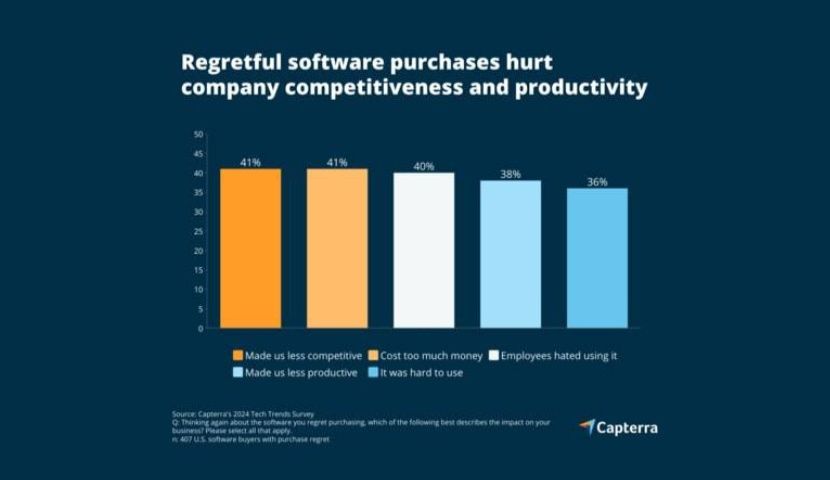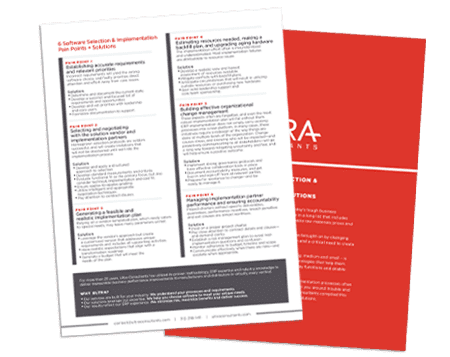Business software selection isn’t to be taken lightly. Choosing the wrong software can ripple through the entire organization. According to Capterra’s Tech Trends Report, fifty-eight percent of U.S. businesses regret at least one software purchase they made in the last 12 to 18 months. Common reasons for the regret include high cost, on-boarding difficulties or vendor-related issues.

Take the case of Lidl, a 10,000-store international supermarket chain. Lidl chose ERP software that needed heavy customization to meet its needs and, after spending €500 million on that effort, was forced to abandon the implementation. That is an extreme example, but buyer’s remorse for enterprise software solutions is a very real phenomenon.
Enterprise software selection has implications that effect every department within a company. The right solution can become an asset, improving business processes like operational efficiency and enabling informed decisions. But making the wrong choice can result in frustrated employees, lost productivity and resource waste.

6 Software Selection & Implementation Pain Points + Solutions
To help you drive success, Ultra’s experts compiled a list of pain points and solutions to be aware of as you embark on your software selection journey.
Ensuring that any potential solutions meet your current and future business requirements demands a cautious, structured approach to the evaluation process. During the decision making process, your organization must consider a variety of critical requirements like scalability, integration capabilities, and user friendliness to avoid mistakes during the business software selection journey which could hinder the success of your business.
The software selection process is made even more complicated due to the wide array of enterprise software on the market. With so many available options, it can be overwhelming for organizations to sift through the noise to identify the best software that can drive success across their business. Therefore, it’s important for your business to assess software features against your business needs while also considering factors like vendor support, long-term product viability, integration capabilities, and ease of implementation to ensure alignment with your unique requirements.
To make the selection process easier, we’ve compiled the following list to help you find the software solution that’s right for your company.
5 Critical Business Software Selection Factors
1. Alignment of Functions and Needs
Most companies will choose enterprise software that solves a business problem, such as reducing manual errors or automating month-end financial closings. When looking at new software, it’s critical to note whether the vendor’s offerings align with the company’s needs. For example, if the organization needs an automated expense reporting feature, and the software doesn’t offer that, keep looking.
2. Vendor Investment in Product
Before making the commitment to a new solution, researching the vendor’s roadmap for the product can prove very illuminating. If the vendor doesn’t have a clear vision or path for updates, that may indicate that the product will be sunset in the all-too-near future. Additionally, the technology roadmap needs to fit with the business strategy – or the organization risks choosing software that will not fit its needs.
3. Interface and User Experience
One way to ensure that nobody in the organization uses the new software properly – or at all – is to choose a solution that is difficult to use. If the majority of employees who need to log in don’t understand the interface or have difficulty navigating to the functions they need, they’ll find workarounds that may not align with the original reasons for purchasing the software. For example, if the company chooses a mobile expense report solution that does a poor job scanning receipts, users may set up their own software and import data into the financial system, possibly introducing errors into the reporting process.

4. Total Cost of Ownership
While cost isn’t the most important factor in choosing software, it is significant. There can be a lot of hidden expenses, particularly when selecting subscription-based enterprise software. Companies need to consider the total cost of ownership (TCO) which includes:
- Licensing fees
- User fees
- Annual maintenance
- Implementation services
- Upgrade costs
- Third-party integration costs and fees
- Support
All of this can add up quickly, and in some cases, might not be apparent until after the implementation is completed. For example, one large ERP vendor charges when third-party programs access data inside the ERP system. This is not a common pricing model, but it’s worth investigating whether this will apply to any chosen vendor.
5. Support
Chances are that the internal IT team can’t answer every question or address every issue that arises. When evaluating any kind of enterprise software, the support offered should play a critical role in the selection process. Ideally, the vendor has a strong ecosystem of support partners, including but not limited to their own phone support, as well as consulting firms and implementation partners.
Ultra Makes it Easy
Selecting the right enterprise software requires careful planning and research to avoid a mistake that could lead to inefficiencies, increased costs and frustrated teams. But by evaluating key factors like functionality, user experience, total costs, and software vendor support options, your business can make an informed choice that sets up your company for long-term success.
With a clear understanding of your organization’s business needs, combined with a methodical approach to the selection process, you can choose a new software that meets your current requirements and also scales for your future growth. A successful selection process yields a solution that sets the stage for improved business processes, streamlined operations and improved decision-making.
The journey to a successful enterprise software selection and implementation doesn’t have to be difficult. Let Ultra Consultants’ experienced software consulting team chart a path toward your company’s growth through business process improvement, technology selection, implementation and value realization. Get started today.
Table of Contents
More ERP material...
Choosing a CRM System for Your Business
Data analytics holds the ability to highlight inefficient manufacturing processes and enable…
The Undeniable Benefits of Implementing ERP in Food and Beverage Manufacturing
Data analytics holds the ability to highlight inefficient manufacturing processes and enable…
Emerging Technologies in Manufacturing Driving Business Growth
Data analytics holds the ability to highlight inefficient manufacturing processes and enable…



